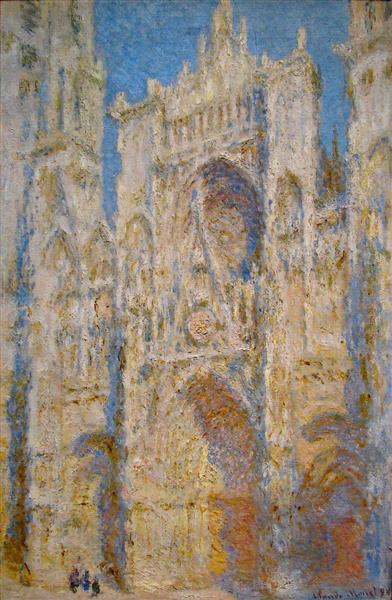Descriere
Pictura „Catedrala lui Rouen - Fațada de Vest - Luz del Sol” (1894) de Claude Monet este ridicată ca o mărturie puternică a capacității artistului de a surprinde esența variabilă a luminii și interacțiunea sa cu arhitectura. Această lucrare aparține unei serii de reprezentări pe care Monet le -a făcut din Catedrala din Rouen, unde a explorat modul în care diferitele momente ale zilei și condițiile climatice transformă percepția aceluiași subiect. În acest tablou, lumina soarelui scade fațada vestică a catedralei, dezvăluind un spectacol vizual care evocă atât maiestatea clădirii, cât și tranziția experienței vizuale.
Compoziția tabloului se caracterizează printr -o structură verticală care evidențiază monumentalismul Catedralei, ale cărui turnuri gotice se ridică la cer. Monet folosește o perspectivă în care fațada are loc frontal, invitând privitorul să facă parte din această experiență vizuală. Textura suprafeței de pictură, obținută prin tehnici libere și libere de periaj, permite fondarea și amestecarea culorilor, creând o atmosferă vibrantă și eterică. Este în această fuziune de lumină și culoare, unde Monet își arată stăpânirea, deoarece scena nu se limitează la a fi o reprezentare fidelă, ci devine o manifestare a percepției subiective.
Culoarea este, fără îndoială, unul dintre cele mai fascinante aspecte ale lucrării. Monet folosește o paletă bogată și variată, unde predomină tonurile calde de galben, portocale și aur, ceea ce sugerează lumina soarelui intensă a momentului zilei. Această alegere a culorii nu numai că oferă un sentiment de căldură și luminozitate, dar îmbunătățește texturarea pietrelor catedralei, care par să prindă viață sub influența luminii. Împreună, lucrarea surprinde o frumusețe efemeră care este caracteristică abordării impresioniste, care este interesată nu numai de ceea ce se vede, ci și cum arată și cum se simte.
Spre deosebire de alte lucrări în care Monet include figuri umane care adaugă un sentiment de scară sau context narativ, în „Catedrala Rouen - fațadă de vest - lumina soarelui”, figura umană este complet absentă. Această decizie consolidează monumentalitatea clădirii și permite atenției privitorului să se concentreze complet asupra catedralei în sine și a luminii care o înconjoară. Absența personajelor sugerează o contemplare tăcută, aproape meditativă, care invită privitorul să reflecte asupra trecerii timpului și a naturii efemere a luminii și existenței.
Această imagine se înscrie, de asemenea, într -un context mai mare în cariera monetului, care la sfârșitul secolului al XIX -lea a fost profund interesat de fenomenul luminii și de impactul acesteia asupra percepției realității. Catedrala Rouen devine un simbol al propriului proces artistic al lui Monet, care a căutat să reprezinte impresia efemeră pe care o poate genera un anumit moment. În acest sens, munca poate fi comparată cu altele din seria sa, unde lumina joacă un plumb.
„Catedrala Rouen - Fațada de Vest - Luz del Sol” este în cele din urmă o lucrare care transcende simplul portret al unei clădiri; Este un studiu al momentului, un dialog între lumină și formă, care surprinde esența impresionismului. Monet constă în experiența vizuală și pune capacitatea culorii de a evoca senzații, transportând privitorul la o percepție mai profundă a lumii din jurul său. Astfel, această lucrare devine un punct de reper nu numai în cariera lui Monet, ci în istoria artei, amintindu -ne de tranziția luminii și eternitatea frumuseții care surprinde.
KUADROS ©, o vopsea faimoasă pe peretele tău.
Picturi de ulei realizate manual, cu calitatea artiștilor profesioniști și sigiliul distinctiv al KUADROS ©.
Imagini Serviciu de reproducere cu garanție de satisfacție. Dacă nu sunteți complet mulțumit de replica tabloului dvs., vă rambursăm banii 100%.

